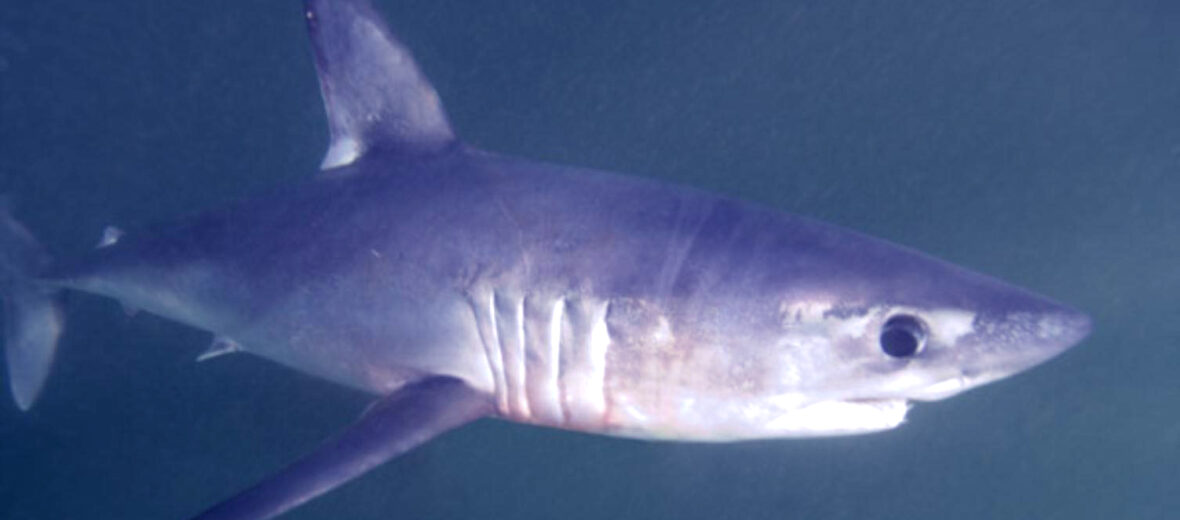
The porbeagle shark is a species of mackerel shark (in the same family as great whites and others) that can be found in the frigid and temperate ocean waters of the North Atlantic and in the Southern Hemisphere. With facing the threat of overfishing and with an ever-decreasing population, these sharks are listed as Vulnerable by the IUCN. The most recent IUCN evaluation of these critters was conducted in 2018.
First the Stats…
Scientific name: Lamna nasus
Weight: Up to 280 lbs.
Length: Up to 8.2 feet
Lifespan: Up to 30 years
Now on to the Facts!
1.) These sharks are most closely related to the salmon shark.
2.) North Atlantic species grow larger than Southern Hemisphere species, and they are of different colors.
3.) They prey on bony fishes and cephalopods.
4.) These sharks are fast and agile swimmers capable of bursts of speed of up to 20 mph.
5.) These sharks have the ability to maintain a warmer body temperature than that of the surrounding water. That’s right, they are warm-blooded and can thermoregulate (control their core temperature).
But wait, there’s more on the porbeagle shark!
6.) Porbeagles can be both solitary and gregarious, and have been documented engaging in almost playful behaviors.
7.) The meat and fins of these sharks are highly prized, which has unfortunately led to a long history of immense human exploitation.
Did you know…?
Porbeagles can dive to depths of up to 4,460 feet.
8.) The females are not only aplacental viviparous (eggs develop inside the female’s body and are born live) but the pups also engage in oophagy (the developing pups will eat any nonviable eggs before being born).
9.) Females undergo up to a 9 month gestation (pregnancy) that yields up to 4 pups.
10.) Porbeagle sharks are considered a game fish by recreational anglers.
But wait, there’s still more on the porbeagle shark!
11.) Unfortunately, due to their low reproductive capacity, these sharks are unable to sustain the continued overfishing they currently endure.
12.) There have only been a handful of reports of shark attacks attributed to the porbeagle, and it is believed that those were provoked attacks.
Did you know…?
These sharks have been documented rolling and repeatedly wrapping themselves in long kelp fronds near the water’s surface. It is uncertain if this is a playful engagement or 1 of necessity where they are actually just feeding off of organism attached to the kelp and/of removing parasites with the help of the sea plants.
13.) The name porbeagle is thought to have derived from “porpoise” and “beagle” attributing to its determined hunting habits.
14.) The first description of these sharks was conducted by French naturalist Pierre Joseph Bonnaterre in 1788. The description was based off of an earlier account by the Welsh naturalist Thomas Pennant, in 1769.
15.) These sharks have been around for an estimated 7.2 million years.
But wait, there’s still a little more on the porbeagle shark!
16.) Orca and great white sharks are known predators of porbeagles.
17.) Known parasites of these sharks are tapeworms and copepods.
18.) Adult porbeagles have been filmed charging at divers working around oil platforms, sometimes they have even brushed lightly against them but without doing any harm. These encounters don’t seem to have any predatory intent and may rather be motivated by curiosity or even defense.
19.) Massive fishing efforts for the porbeagle shark dates back to the 1930s, back when Norway and also Denmark started operating longline vessels in the Northeast Atlantic.
20.) Since 2011, all fishing for these sharks has been made illegal in waters of the European Union, and EU-registered vessels are also subsequently prohibited from fishing for the species even in international waters.
Now a Short Porbeagle Shark Video!
Be sure to share & comment below! Also, check out the Critter Science YouTube channel. Videos added regularly!
Want to suggest a critter for me to write about? Let me know here.
Some source material acquired from: Wikipedia & IUCN
Photo credit: Dive Advisor



